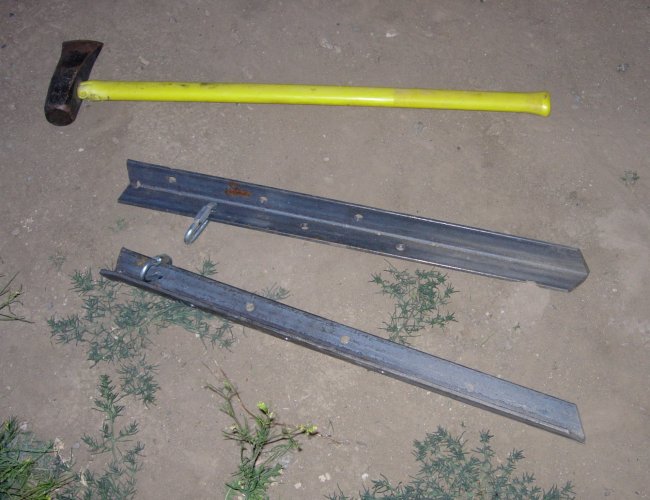Winch "self rescue" equipment
(or what do you do when there are no trees?)
Living here in Oregon as I do, there are nearly always trees within
arms reach. Well at least if you stay in the coast range there are. So
should you find yourself stuck, winching is not a problem. But if you
venture into eastern Oregon you may find yourself without a good winch
anchor. And if you are like my buddy Jim in Nevada, then you have
thousands (hundreds of thousands!) of acres with nothing but sand and
sagebrush. A stuck rig without 10 miles of winch cable can be a real
problem.
We have all heard of the plan in which you 1) dig a hole, 2) place
spare tire in hole and cover with dirt, 3) winch to spare tire, 4) dig
out spare tire, 5) repeat until you die of exhaustion (pretty quickly I
think). This sounds like (at best) a lot of hard work.
What is needed is a good self rescue technique. After all, if you were
sensible and had a buddy along to pull you out you wouldn't be stuck.
Jim and I set off looking for a good solution. We aren't done yet, but
here we show you some prototype work from our June 2006 testing.
The basic plan is to have sections of angle iron driven into the ground
with the top of one section (say a foot out of the ground) anchored to
another section at ground level. The less solid the ground the more
angle iron you use.
 In
this test we used two sections of 1/4 inch thick angle iron 2 inch by
30 inch positioned about 10 feet apart and driven into the ground with
about 10 inches of angle iron left above the ground. We had a series of
holes drilled in the angle iron so we could secure a winch cable at
ground level of one piece and then anchor the top of that piece to
ground level of the second piece.
In
this test we used two sections of 1/4 inch thick angle iron 2 inch by
30 inch positioned about 10 feet apart and driven into the ground with
about 10 inches of angle iron left above the ground. We had a series of
holes drilled in the angle iron so we could secure a winch cable at
ground level of one piece and then anchor the top of that piece to
ground level of the second piece.
 Here
you see the two pieces of angle iron driven into the ground with winch
cable attached at ground level. The top of the front post is anchored
to the rear post at ground level. We used a "ratcheting strap" but
chain is probably much better.
Here
you see the two pieces of angle iron driven into the ground with winch
cable attached at ground level. The top of the front post is anchored
to the rear post at ground level. We used a "ratcheting strap" but
chain is probably much better.

For our test we parked a Ford F-250 (8,000 lbs!) in a ditch, with
parking brake on, and winched it out of the ditch. It was dragging the
tires and really pulling on that winch cable.
One of the things we learned from our testing is that some sort of
"cap" for the angle iron would be useful. Swinging a sledge down on a
small target is not easy. Placing a cap of some sort on the angle iron
would give a larger target and keep the angle iron from getting badly
smashed, giving you multiple uses. This was our initial prototype
testing. More testing will follow.
 In
this test we used two sections of 1/4 inch thick angle iron 2 inch by
30 inch positioned about 10 feet apart and driven into the ground with
about 10 inches of angle iron left above the ground. We had a series of
holes drilled in the angle iron so we could secure a winch cable at
ground level of one piece and then anchor the top of that piece to
ground level of the second piece.
In
this test we used two sections of 1/4 inch thick angle iron 2 inch by
30 inch positioned about 10 feet apart and driven into the ground with
about 10 inches of angle iron left above the ground. We had a series of
holes drilled in the angle iron so we could secure a winch cable at
ground level of one piece and then anchor the top of that piece to
ground level of the second piece. Here
you see the two pieces of angle iron driven into the ground with winch
cable attached at ground level. The top of the front post is anchored
to the rear post at ground level. We used a "ratcheting strap" but
chain is probably much better.
Here
you see the two pieces of angle iron driven into the ground with winch
cable attached at ground level. The top of the front post is anchored
to the rear post at ground level. We used a "ratcheting strap" but
chain is probably much better.